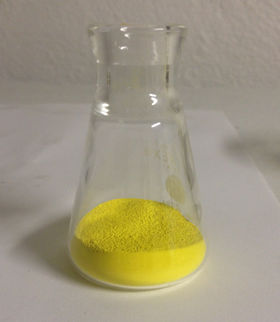Zinc chromate
 Zinc chromate sample
| |
| Names | |
|---|---|
| IUPAC name
Zinc chromate
| |
| Other names
Zinc chromate C
Zinc yellow | |
| Properties | |
| ZnCrO4 | |
| Molar mass | 181.403 g/mol |
| Appearance | Yellow solid |
| Odor | Odorless |
| Density | 3.43 g/cm3 |
| Melting point | 316 °C (601 °F; 589 K) |
| Boiling point | 732 °C (1,350 °F; 1,005 K) |
| 3.08 g/100 ml | |
| Solubility | Soluble in ammonia Insoluble in organic solvents |
| Vapor pressure | ~0 mmHg |
| Hazards | |
| Safety data sheet | Cameo |
| Flash point | Non-flammable |
| Lethal dose or concentration (LD, LC): | |
| LD50 (Median dose)
|
500 mg/kg (rat, oral) |
| Related compounds | |
| Related compounds
|
Lead(II) chromate |
| Except where otherwise noted, data are given for materials in their standard state (at 25 °C [77 °F], 100 kPa). | |
| Infobox references | |
Zinc chromate, sometimes known by the trade name Zinc Yellow is an inorganic compound with the chemical formula ZnCrO4. It is a lemon-yellow solid sometimes used as a pigment.
Contents
Properties
Chemical
Like other chromates, zinc chromate is an oxidizer and may react with certain organic materials.
Upon treatment with hot solutions of sodium hydroxide, the color gradually lightens to white, reflecting conversion to zinc oxide and the formation of sodium chromate in solution.
- ZnCrO4 + 2 NaOH → Na2CrO4 + ZnO + H2O
Physical
Zinc chromate most often appears as a dense, odorless, lemon-yellow powder, making it a desirable pigment. Unlike its more toxic counterpart, lead(II) chromate, zinc chromate may degrade in color over time in bright light. Among pigments, however, it is still considered light-stable and is far less toxic than cadmium or lead yellows, making it more desirable than these.
Preparation
Zinc chromate is easily produced by the combination of a solution of sodium or potassium chromate with a solution of zinc nitrate, chloride, sulfate or another water-soluble zinc salt.
- Na2CrO4 + Zn(NO3)2 → ZnCrO4 + 2 NaNO3
- Na2CrO4 + ZnCl2 → ZnCrO4 + 2 NaCl
- Na2CrO4 + ZnSO4 → ZnCrO4 + 2 Na2SO4
The brightest yellows appear to emerge from slightly acidic solutions at elevated temperature.
Projects
- Homemade yellow paint
- Make sodium chromate
Handling
Safety
Zinc chromate, as with all other zinc compounds, is toxic if consumed, and can lead to zinc poisoning in the body. The hexavalent chromium in zinc chromate is also a potent oxidizer, and has been demonstrated to be carcinogenic. It is best to handle this compound with gloves, although given its insoluble nature, it is unlikely that one would incur harm from anything less than inhaling or eating it. Additionally, it is still far less toxic than other yellow pigments, such as lead(II) chromate or cadmium sulfide.
Storage
Zinc chromate is very stable and does not require special storage considerations. A plastic bottle with a proper label and a hazard symbol is a suitable container.
Disposal
As mentioned above, boiling sodium hydroxide solution leaches zinc chromate, producing relatively harmless zinc oxide and a solution of sodium chromate. The chromate solution can be acidified and reduced with sulfite or ascorbic acid and disposed of.